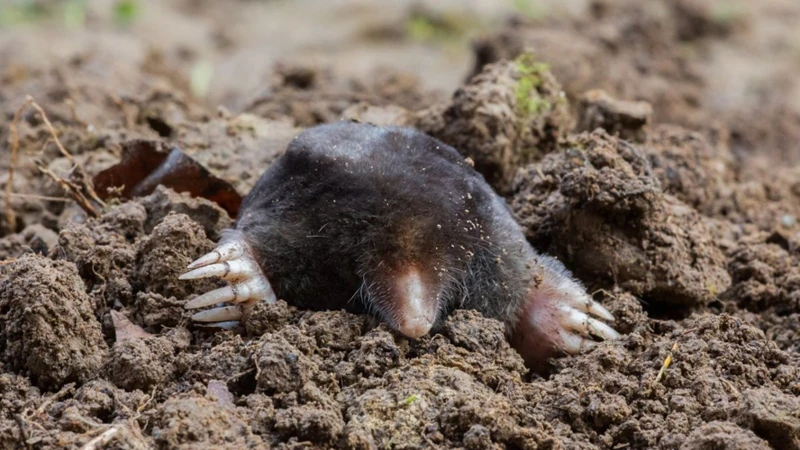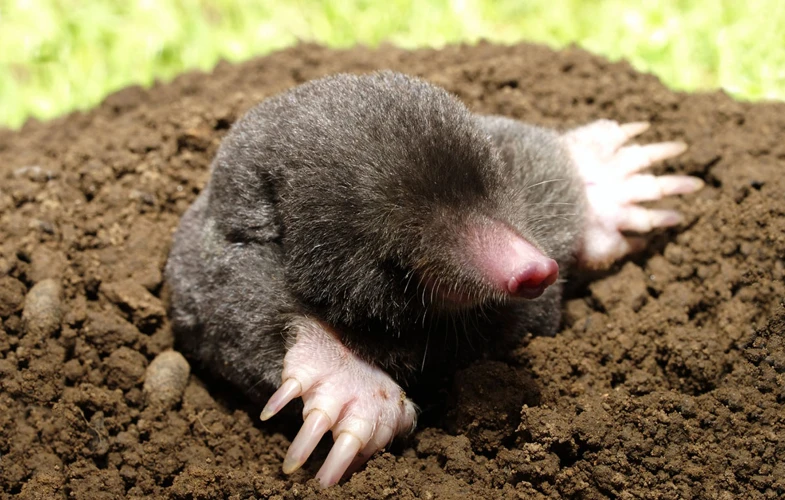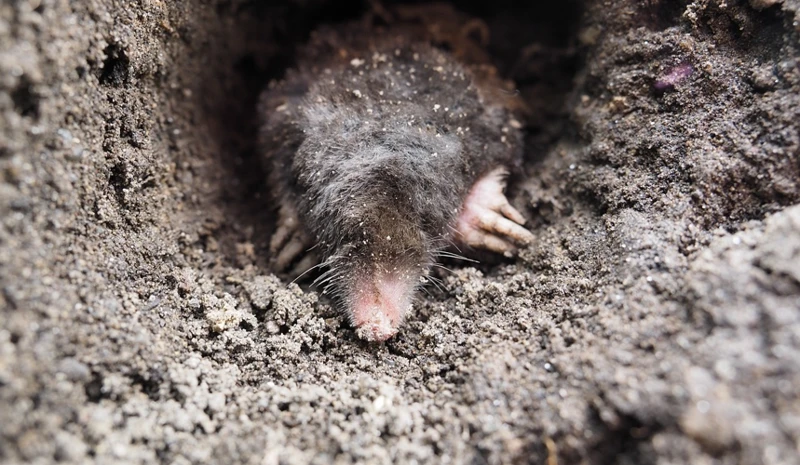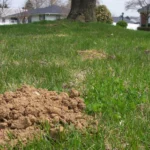Picture a yard riddled with tunnels and hills, like miniature mountains popping up out of nowhere. Who could have done this mischief? More likely than not, it’s our mole friends at work. But have you ever wondered why moles seem to prefer one area over another? It turns out that soil type plays a significant role in their habitat choices. Let’s explore this topic in-depth to understand how soil type impacts the behavior of moles and what we can do to deter them from our yards.
The Role of Soil Type in Mole Habitats

It may come as a surprise to many homeowners that the type of soil in their yard can greatly impact mole habitats. Moles are burrowing creatures that require specific soil conditions to create their complex tunnel systems. The soil type can affect both their behavior and the success of their habitats. Understanding the role of soil type in mole habitats is essential for homeowners looking to create an environment that is unattractive to moles. In this article, we will take a closer look at the relationship between soil type and mole habitats, as well as explore ways to deter moles from taking up residence in your yard. To learn more about mole habitats in yards, check out our article on creating unattractive environments for moles.
What Soils do Moles Prefer?
Moles are known to prefer soils that are easy to dig and do not clump together, allowing them to create their intricate tunnel systems with ease. Sandy soil, for instance, is a favorite among moles, as it has very low clay and organic matter content, which makes it easier for them to dig through. Loam soil, which contains a balance of sand, silt, and clay, is also a preferred soil type for moles, as it provides the perfect balance of water drainage and compaction for tunneling.
Moles tend to avoid soils that are rocky or gravelly, as these soil types can be difficult to dig through. Rocky soil can make digging tunnels troublesome as roots and rocks can hinder the expansion of tunnels. However, if a mole was born in rocky soil it may continue to burrow tunnels in such areas. Gravelly soil is also difficult for moles to dig through as the gravel can be abrasive on their sensitive faces.
While heavy soil that is high in clay content can be a preferred soil type for moles, it can also be cumbersome to burrow through as it can be quite sticky and challenging to dig through. Clay soils can be challenging to tunnel through and can become waterlogged quickly, which can be detrimental to the mole’s living condition. Mole tunnels might collapse from water damage and flooding.
The preference for soil type is primarily dependent on the moles’ environment and the availability of food sources. Understanding what soil types moles prefer can help you better detect mole tunnels and ensure that your yard is unattractive to moles. If you want to learn more about moisture in mole habitats, check out our article on moisture in mole habitats, and if you want to learn how to detect mole tunnels, visit our article on detecting mole tunnels.
How Soil Type Impacts Mole Behaviour
Soil type has a significant impact on mole behavior. Mole’s primary source of food is earthworms, and they rely on their sense of touch and smell to locate them. The texture and moisture level of soil can affect earthworm mobility, and soil type determines its overall moisture content. For example, moles prefer loamy soil with high moisture content because it makes tunneling and movement easier. However, if the soil is too dry, hard, or rocky, it can make movement difficult, and moles may avoid that area.
Soil type can affect mole behavior through its impact on vegetation. Mole tunnels can damage plant roots, which could be boosted or hindered by the soil type. Sandy soil, for example, doesn’t hold much water, meaning plants in dry conditions may rely on the mole tunnels for moisture. Conversely, wet soil type may affect plant growth adversely, making the area unattractive to moles.
Soil type can also affect the visibility of mole tunnels. Light sandy soil and dry soil, especially in sunny open areas or slopes, are more likely to support visible mole tunnels. However, mole tunnels may be harder to spot in dense, grassy areas or heavy, wet soil, similar to those supported by clay soil.
Moles, believing there are predators, for food, or environmental conditions, can dig deeper into the soil, and the soil structure can cause different digging behaviors. Through a compact, heavy substance like clay or wet soil, they may need to dig less to maintain a tunnel structure. On the contrary, some soil types like rocky or mixed soil can slow mole progress, making it difficult for them to dig in such an area.
Ultimately, soil type plays a significant role in where moles can establish their habitats. Thus, it’s necessary to consider the soil type before creating unattractive conditions for moles in the yard.
When Soil Type May Not Matter
When Soil Type May Not Matter
While soil type plays a critical role in creating optimal mole habitats, it is not always the deciding factor. Moles are adaptable creatures and can thrive in a variety of soil types. In fact, they can even create burrows in rocky or heavily compacted soil, albeit with difficulty.
Other factors such as food availability, moisture levels, and temperature can have a far greater impact on a mole’s behavior than soil type. For example, during dry spells, moles may venture into areas with soils that are less than ideal for tunneling in search of food and water.
Additionally, maintaining a well-manicured lawn can help deter moles from creating habitats in the first place. Regular watering and fertilizing, combined with frequent trimming and aerating of the soil, can make a yard less appealing to moles.
In some cases, when moles have already established their habitats in a particular area, trapping or relocating them may be necessary. However, it is important to note that some states have regulations regarding mole removal, so it is essential to check local laws before taking action.
By understanding the impact of soil type on mole habitats, as well as other factors that may influence their behavior, homeowners can take the necessary steps to maintain a mole-free lawn.
Soil Types to Deter Moles

So you might be wondering: what kind of soil can deter moles from creating habitats in your yard? With a little bit of knowledge about soil types, you can take simple steps to minimize the likelihood of moles building homes where they aren’t welcome. In this section, we’ll explore different soil types and their impact on mole behavior. By the end, you’ll have a good idea of which soil to use to discourage moles from sticking around. Whether you’re exploring different mole removal strategies (/mole-habitats-removal/), hoping to establish a veggie garden in your yard (/veg-mole-habitats/), or just curious about seasonal mole behaviors (/seasonal-mole-habitat-behavior/), understanding soil types is an important part of creating a mole-free environment.
Sandy Soil
Sandy soil is a type of soil that has very large particles, making it porous and easy to drain. This type of soil is often found in coastal areas and deserts. While moles can create tunnels in sandy soil, it may not be the best environment for them to thrive in due to its loose texture.
Advantages of Sandy Soil for Moles:
- Easy to excavate
- Allows for good drainage
However, sandy soil has some disadvantages for moles as well. Since it is not compact, tunnels can collapse more easily. Additionally, the loose soil can make it more difficult for moles to move quickly through their tunnels. This can make it harder for them to find food and escape from predators.
How to Deter Moles in Sandy Soil:
- Installing a physical barrier like wire mesh or hardware cloth to prevent moles from burrowing in gardens or lawns.
- Planting certain types of vegetation that moles dislike, such as daffodils, alliums, and marigolds.
- Using castor oil-based repellents, which are non-toxic and can help keep moles out of an area.
- Regular maintenance of the yard, such as mowing the grass and removing debris, can discourage moles from taking up residence in the area.
While moles can certainly survive in sandy soil, they may not be as comfortable or successful in this type of environment as they would be in other types of soil. By taking steps to deter moles, homeowners can protect their lawns and gardens while creating a more welcoming environment for other types of wildlife.
Rocky Soil
Rocky soil may not be the most ideal habitat for moles as they prefer loose, well-draining soil that is easier to burrow through. The presence of rocks and stones in the soil can make it difficult for the moles to excavate tunnels and construct their underground networks. However, there are certain types of moles that have adapted to living in rocky soil.
Mole Species That Thrive in Rocky Soil:
| Mole Species | Adaptations |
|---|---|
| Star-nosed Mole | Has specialized claws that allow it to grasp onto rocks and dig through hard soil. |
| Hairy-tailed Mole | Capable of burrowing through tough soil and rocks due to its powerful forelimbs and large claws. |
These mole species’ exceptional adaptations to rocky soils allow them to still thrive in areas that are unsuitable for other types of moles. However, it is important to note that even for these species, soil without rocks is still far easier to excavate and can be seen as more attractive habitat.
If your yard has rocky soil, it may be more difficult to deter moles, but there are still things you can do to minimize the damage they cause. Maintaining a well-manicured yard and controlling soil moisture can help to attract moles to other areas, such as nearby fields and forests, instead of your yard.
Gravelly Soil
Gravelly soil is a type of soil that is characterized by the presence of gravel or pebbles. This type of soil is well-drained and allows water to move freely through it, which makes it a suitable habitat for moles. However, moles prefer soil that is easy to dig through, and gravelly soil can be a bit of a challenge for them.
Advantages of Gravelly Soil for Moles
Gravelly soil is often found in areas with rocky or mountainous terrain, where the soil has been eroded away over time. This type of soil provides moles with the space they need to burrow and create their tunnels. Additionally, the presence of gravel in the soil can provide extra protection for the mole’s tunnels, making it more difficult for predators to dig them up.
Disadvantages of Gravelly Soil for Moles
Despite the advantages, moles may find it difficult to dig through the gravelly soil. The presence of gravel and pebbles in the soil can slow down their digging process and require more effort. Gravelly soil lacks the necessary nutrients, moisture, and organic matter that moles need to survive. This type of soil is also prone to drought, which can make it difficult for moles to find food.
How to Deter Moles in Gravelly Soil
If you have a garden or lawn with gravelly soil that is attracting moles, there are several ways to deter them. One common method is to plant certain types of plants that moles don’t like, such as daffodils, marigolds, and alliums. Another way to deter moles is to use sonic-emitting devices that emit high-pitched sounds that moles find uncomfortable. Traps and mole repellents are also options, but they should be used with caution to avoid harming the moles or other wildlife in the area.
While gravelly soil can provide moles with a suitable habitat, it’s not their preferred soil type. Gravelly soil can slow down their digging and lacks the necessary nutrients and moisture for their survival. Homeowners with gravelly soil can take steps to deter moles, such as planting certain plants or using sonic-emitting devices.
Heavy Soil
Heavy soil is another type of soil that can deter moles from making their habitat. This type of soil has a high clay composition, which makes it difficult for moles to construct their tunnels. The heavy soil is dense and retains water, which makes it sticky, thus unable to hold up tunnels for a long time.
Advantages of Heavy Soil:
- Reduced drainage:
- Heavy soil has a high water-holding capacity that makes it great for plants to retain water, especially during dry seasons.
- Drought-resistant:
- Heavy soil provides plants with enough moisture, even when the surrounding environment is dry or hot.
- Nutrient-rich:
- Heavy soil has a high amount of organic material that provides nutrients to plants.
Disadvantages of Heavy Soil:
- Compaction:
- Heavy soil can become compact over time, making it difficult for plants to grow well. The density of heavy soil can also make it challenging for soil organisms to move around, which can lead to a decline in soil health.
- Drainage Issues:
- Heavy soil can hold onto too much water, which may lead to waterlogging, especially during rainy seasons. This can cause damage to the plants and the soil, making it prone to soil erosion, landslides, and other soil problems.
- High Cost:
- Heavy soil requires a lot of energy and resources to prepare and maintain. This makes it more expensive than other types of soils such as sandy or loamy soils.
While heavy soil can deter moles from making their habitat, it is important to balance the advantages and disadvantages before considering it as the best option for the yard. A well-maintained heavy soil can provide numerous benefits to plants, but it requires a lot of effort and resources to keep it healthy.
Clay Soils
One common type of soil found in many gardens is clay soil. This type of soil is known for its dense and fine texture, making it challenging to work with. Despite its difficulties, clay soil can provide a rich feeding ground for moles. But how exactly does clay soil impact mole habitats?
To better understand the relationship between clay soil and moles, let’s look at some of its characteristics:
| Characteristics | Impact on Moles |
|---|---|
| Heaviness | Some moles may struggle to dig through the dense clay. However, if they can manage, the heaviness of the soil can provide a stable home for moles. |
| Moisture Retention | Clay soil can retain moisture well, which can be advantageous for moles as they require damp soil to burrow through easily. |
| Poor Drainage | This can result in waterlogging, which can be problematic for plants but can actually increase earthworm populations, improving the food supply for moles in the area. |
| Nutrient Rich | Clay soil is high in nutrients, making it a fertile ground for earthworms and other insects. As moles feed on these creatures, the nutrient-rich soils can significantly benefit mole populations in the area. |
While clay soil can be a favorable environment for moles to thrive in, it’s essential to understand that not all mole infestations will happen due to soil type. There are various other factors at play, including food availability and weather conditions.
To keep moles away from clay soil areas, there are a few steps gardeners can take. Maintaining proper drainage and aeration can help keep the soil from becoming waterlogged, and reducing overwatering can also help to keep the soil drier. Planting certain plants, such as Alliums, Fritillaries, and Castor Oil Plants, are known to repel moles.
While clay soil may benefit mole populations, it is not the sole factor that drives them to a particular location. Gardeners should focus on maintaining a balanced ecosystem in their yards and work towards deterring moles as a part of that process.
Loam Soil
Loam soil is considered to be the ideal soil type for mole habitats. It is a mixture of sand, silt, and clay that provides the perfect environment for moles to burrow in. The unique composition of loam soil provides several benefits for mole activity, including good drainage, good moisture retention, and adequate aeration.
Benefits of Loam Soil for Mole Habitats:
- Good Drainage: Loam soil has a good drainage system that allows excess water to drain away from the surface, preventing waterlogging of mole tunnels. This feature ensures that the mole tunnels remain dry, providing an optimal environment for moles to forage and burrow.
- Good Moisture Retention: Loam soil has adequate moisture retention, which means that the soil can hold water for a longer period, providing a consistent supply of moisture to the mole tunnels. This feature is particularly necessary in arid regions where water is scarce.
- Adequate Aeration: Loam soil has good aeration properties due to its unique mixture of sand, silt, and clay. This property provides adequate oxygen supply to the mole tunnels, allowing the moles to breathe comfortably.
Loam soil also has excellent nutrient content, making it an ideal habitat for earthworms and other soil organisms that moles feed on. The earthworms thrive in the loam soil, providing a ready source of food for moles.
Loam soil is the preferred soil type for mole habitats due to its excellent drainage, good moisture retention, and adequate aeration. The nutrient content of loam soil also makes it an ideal habitat for earthworms, which are a primary food source for moles.
Which Soil Type is Best?
When it comes to determining which soil type is best for deterring moles, no one type stands out as the ultimate solution. Each soil type has its advantages and disadvantages in terms of mole activity. Below are the characteristics of each soil type, and their suitability for deterring moles.
- Sandy Soil: Sandy soil is generally looser and easier for moles to dig through. It does, however, provide better drainage which can keep the soil dry and less attractive to moles.
- Rocky Soil: Rocky soil is difficult for moles to dig tunnels in, and they are less likely to inhabit areas with large rocks.
- Gravelly Soil: Gravelly soil has elements of both sandy and rocky soil. It can help with drainage, but also provides a challenge for moles to dig through.
- Heavy Soil: Heavy soil, such as clay, can be challenging for moles to dig through. However, it is often rich in nutrients and attractive to earthworms, which can still draw mole activity.
- Clay Soil: Clay soil is often too heavy for moles and less likely to attract them. However, it can become waterlogged, making it an ideal spot for moles looking to escape wet soil elsewhere.
- Loam Soil: Loam soil is a mixture of sand, silt, and clay and often provides the optimal conditions for plant growth. It is also a suitable habitat for moles as it contains earthworms and good moisture levels.
Choosing the best soil type to deter moles depends on the specific characteristics of your yard and the surrounding environment. It’s essential to consider factors such as drainage, nutrient levels, and the presence of earthworms when deciding which soil type to use to deter mole activity.
Maintain The Yard
Maintaining the yard is crucial when it comes to discouraging moles from inhabiting the area. Moles seek out yards that have an abundance of insects and grubs for food, so it’s important to keep the lawn healthy and free of pests that may attract moles.
Regular Lawn Maintenance: Keeping the lawn mowed and trimmed regularly can help make the yard less attractive to moles. Moles prefer taller grass, so keeping the lawn short can discourage them from digging in the area.
Remove Garden Debris: Fallen leaves, dead grass, and other garden debris provide the perfect shelter for insects and grubs that moles feed on. Removing this debris can help prevent moles from finding a food source in the yard.
Use Natural Deterrents: Planting natural deterrents such as daffodils, alliums, and fritillaries in the yard can help repel moles. These plants contain chemicals that are toxic to moles and can keep them away.
Install Barriers: Installing barriers such as mesh wire or underground fencing can help prevent moles from accessing the lawn. This can be especially useful for areas where moles are known to be a problem.
Avoid Overwatering: Overwatering the lawn can lead to an increase in insect activity, which can in turn attract moles. It’s important to water the lawn only when necessary and to avoid overwatering.
By following these guidelines and maintaining the yard properly, homeowners can greatly decrease the likelihood of moles inhabiting the area. It’s important to remember that while certain types of soil can attract moles, proper yard maintenance can go a long way in deterring them from taking up residence in the yard.
Conclusion
After exploring the impact of soil type on mole habitats, it is evident that the type of soil in your yard can greatly affect the presence and behavior of moles. Moles tend to thrive in moist, loose soil that is easy to dig, and will dig burrows and tunnels to create a habitat for themselves. While all soil types can provide a mole habitat, some are more attractive and conducive to burrowing than others.
It is important to note that while certain soil types may deter moles, they are not foolproof methods for mole control. Ultimately, maintaining a healthy and well-manicured yard is the best way to prevent mole infestations. This includes regularly watering and fertilizing your lawn, removing excess thatch, and ensuring proper drainage.
If you do encounter mole activity in your yard, it is best to consult a professional pest control service to safely and effectively remove the moles without causing harm to yourself or the environment.
In conclusion, understanding the impact of soil type on mole habitats is a crucial aspect of maintaining a healthy and mole-free yard. By being mindful of the soil type in your yard and taking necessary preventative measures, you can ensure that your lawn remains a haven for you and your family, instead of pesky and unwanted moles.
Frequently Asked Questions
What is a mole?
A mole, or Talpa europaea, is a small mammal that burrows underground and creates tunnels or burrows for themselves.
How do moles impact soil?
As moles burrow through the soil, they disturb the structure of it and can cause damage to plant roots. They may also bring up subsoil to the surface, altering the soil composition.
What is the best soil type for moles?
Moles prefer soil that is loose, moist, and easy to burrow through. This includes loamy soil or soil high in organic matter.
Can soil type affect mole behavior?
Yes, soil type can impact mole behavior. Soil that is too compact or contains too many rocks may deter moles from creating burrows. Soil with too much clay can also cause difficulties for moles to burrow.
Is it possible to deter moles by altering soil type?
Yes, altering soil type can potentially deter moles. Certain soil types such as heavy or gravelly soil may be less desirable for moles to create burrows in.
What other methods can be used to deter moles?
Other methods for deterring moles include using sonic devices, planting specific plants that moles dislike, or using mole traps.
Why is it important to maintain the yard to deter moles?
Regular yard maintenance such as removing excess thatch and controlling grubs and other insects can help deter moles. Overgrown yards or yards with excessive thatch can provide ideal habitat for moles.
Can chemicals be used to deter moles?
Chemicals such as castor oil or mole repellent granules can be used to deter moles. However, it is important to follow instructions carefully and not use excessive amounts, as this can harm other wildlife and plant life in the area.
What are the benefits of having moles in the ecosystem?
Moles play an important role in aerating soil and controlling insect populations. Their burrowing can also create channels for water to flow through soil, helping to prevent erosion.
Can moles be relocated?
It is generally not recommended to relocate moles, as they may not survive in their new habitat and can cause problems for other ecosystems. The best practice is to deter them from areas where they are causing damage.







